Two

West Sussex
www.amberleycastle.co.uk
Originally constructed as a twelfth-century manor house and fortified in 1377, Amberley Castle was used as a fortress by the bishops of Chichester and now operates as a hotel. During the English Civil War, it was a Royalist stronghold, and Oliver Cromwell ordered General William Waller to attack the castle, resulting in the loss of twenty feet from the height of the walls and the destruction of the Great Hall.
The castle was later sold but once again given back to the Bishop of Chichester after the Restoration of the Monarchy in 1660.
In 1872, the castle was sold to Lord Zouche, who used it as a hunting lodge before selling it to Henry Fitzalan-
Howard, fifteenth Duke of Norfolk in 1893, after which it was extensively modernized. Since then it has passed through a number of hands.
The castle has its own resident ghost, named Emily. Who she was is unknown, but her apparition is easily the most commonly encountered spirit. It is believed that she committed suicide, however, her reasons for doing so are unknown.
She has been described as having long brown hair and wearing a Victorian-style dress, and has been seen walking along corridors and even through walls. She is known to be a friendly spirit and those who have encountered her remark that they feel a strange calmness in her presence.
Another resident spirit, however, does not seem so friendly, indeed, though no one has actually seen him, many people passing through a certain room in the castle have claimed to have suddenly felt an intense feeling of having someone right behind them, as well as being watched. Fortunately, this spirit seems to be restricted to the one room that is directly above the portcullis.
West Sussex
www.arundelcastle.org
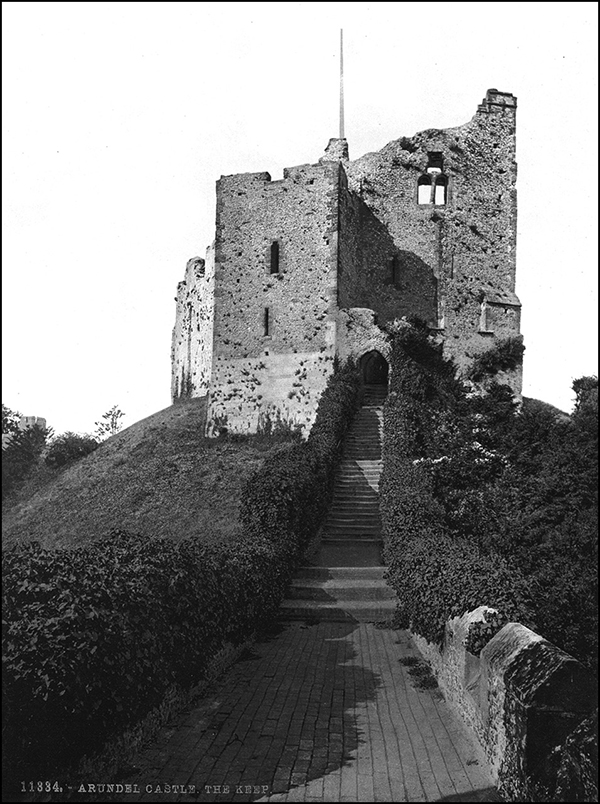
Arundel Castle is a restored medieval castle that was first owned by Roger de Montgomery in 1067. Roger, who was either a cousin or half-brother of William the Conqueror, was rewarded for his loyalty and was granted land in the Welsh Marches and across the country. The original structure was a motte-and-double-bailey castle.
The castle has been under the ownership of the family of the Duke of Norfolk for over four hundred years, and it is the principal seat of the Norfolk family. Grade I, it was damaged during the English Civil War and then restored in the eighteenth and nineteenth centuries. Today the castle remains the principal seat of the Dukes of Norfolk and most of the castle and its grounds are open to the public.
It is a stunning and wondrous sight sitting in forty acres of grounds and containing priceless works of art, ranging from paintings and furniture, tapestries and stained glass, to sculptures and carving, as well as heraldry and armor. In the light of a warm summer day, it does not appear haunted in any way. However, this is not the case.
A ghost known as the Blue Man and suspected to be from the period of Charles II is said to browse books in the library while the ghost of a young boy who is thought to have worked in the kitchens two hundred years ago and who was beaten frequently by his master, appears scrubbing pots and pans and scurrying around the kitchen. There have also been reports of people hearing the banging and crashing of kitchen utensils even though the area is uninhabited.
The ghost of a young woman dressed in white has also been seen on moonlit nights wandering around Hiorne’s Tower, located behind the castle in Arundel Park and designed in the eighteenth century by architect Francis Hiorne. It is thought that she committed suicide, throwing herself off the Tower after losing the love of her betrothed.
As well, a ghostly white bird has been seen fluttering around the windows of the castle and its appearance is said to coincide with the sudden death of a resident of the castle. Interestingly, various Dukes used to keep white American Owls at the castle in the past.
In 1958, another strange sighting was made by a footman who was working late one night on the ground floor. Apparently he was walking near the servant’s quarters and saw what he thought to be a man walking in front of him. As he got closer to the apparition it faded and disappeared.
My visit to the castle in 2010, however, was uneventful—its ghosts deciding to remain quiet and hidden from view. And yet, wandering its ancient corridors with carved arches and cracked stone floors one could believe that it is haunted and, although I am sceptical, a photo I took during my visit showed up a strange anomaly, almost like the white shirt of a person passing a door. Of course, as pointed out by Kirsten, it could equally be a stain or light on the door. Whatever the case, I certainly didn’t notice it at the time.
Surrey
www.dorkingmuseum.org.uk/local-history
/great-estates/betchworth-castle/
Now a crumbling ruin, Betchworth Castle is a shell of its former glory as a fortified medieval stone house. Built on a sandstone spur overlooking the western bank of the River Mole in Surrey, it is a Scheduled Ancient Monument.
Originally an earthwork fortress built by Robert Fitz Gilbert in the eleventh century, the castle was held by Richard de Tonbridge at the time of the Domesday Book. It was then granted to Richard FitzAlan in 1373 and his son, Sir John FitzAlan, turned it into a stone castle in 1379. It passed by marriage to Sir Thomas Browne, Sheriff of Kent, who rebuilt it in 1448 as a fortified house
In the nineteenth century, there was little practical use for castles, and Betchworth was abandoned in the 1830s. It was then bought in 1834, but the new owner demolished parts of it for reuse in other buildings. Without a permanent tenant, the remainder gradually fell into ruin and later became treated as a folly.
The castle is said to be haunted by a black devil-dog that prowls the ruins at night as well as the grounds of the castle, now Betchworth Park golf course.
Also known as devil-dogs or Black Shuck, among other names, black dogs are essentially a nocturnal specter and its appearance is often regarded as a portent of death. In general, they are much larger than a physical dog and are quite often reported as having large, glowing eyes and a silent gait. According to some legends, to see one three times will result in the witness dying an untimely and suspicious death. Not surprisingly they are often associated with moors, lonely back roads, and crossroads and in this case, the castle.
In addition, one owner, purported to be Lord Hope, chased and killed who he thought was an escaping convict with his sword. He later tragically discovered that it was in fact his own son he had killed. As a result, his remorseful ghost is said to wander the grounds.
East Sussex
www.nationaltrust.org.uk/bodiam-castle
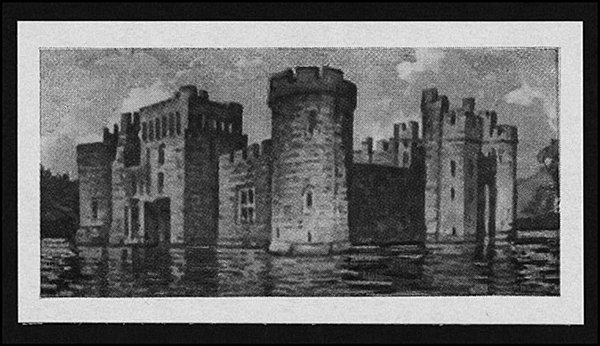
Built in 1385 by Sir Edward Dalyngrigge, a former knight of Edward III, Bodiam Castle is a fourteenth-century moated castle constructed to defend the area against French invasion during the Hundred Years’ War. Built to a quadrangular plan, it has no keep, instead having its various chambers built around the outer defensive walls and inner courts. Its corners and entrance are marked by towers and topped by crenulations.
Now just a ruin, its structure, detail, and placement within an artificial water-surrounded landscape indicate that display was as important an aspect of the castle’s design as defense. Indeed, although licensed for military defense, some believe the castle is nothing more than a fancy manor built to boost the reputation of its owner. Whatever the case, it is considered one of the last great medieval castles in England.
Although never involved in any war, Bodiam Castle houses a number of spectral entities like most medieval castles across the land. And as Richard Jones noted in his book Haunted Castles of Britain and Ireland, “Some people passing the ruins at dead of night have reported the distinctive sound of spectral revels emanating from the hollow shell. Others have told of hearing strange oaths and foreign-sounding songs.”
As well, there is a mysterious red lady who is sometimes seen gazing from one of the towers, her eyes fixed upon some distant unknown object. Although quite famous, no one is quite sure who she is.
Another mysterious spirit involves a little boy dressed in clothes that appear to be straight out of a Dickens novel. His ghost was seen in 1994 running toward the castle but vanished midway across the bridge, suggesting he may have fallen into the moat and drowned. As with the Red lady, nothing else is known about him.
Berkshire
www.english-heritage.org.uk/visit/places/donnington-castle
A ruined medieval castle in the English county of Berkshire, it was founded by Sir Richard Abberbury the Elder in 1386 and at one stage was bought by Thomas Chaucer before being taken under royal control during the Tudor period. During the first English civil war, the castle was held by the Royalists and endured an eighteen-month siege, after which the garrison eventually surrendered. The castle was subsequently demolished in 1646 and only the substantial four towered gatehouse survives as a scheduled ancient monument.
The castle and its grounds are reputed to be haunted by several different ghosts. The gatehouse itself is home to the ghost of a guard who appears in solid form and suddenly vanishes. He has been seen on both floors of the gatehouse and is often mistaken for a guide in period dress. A ghostly reenactment of a skirmish between a Royalist cavalry patrol from the castle and a parliamentary force has also been reported, while in 1990 several visitors witnessed the apparition of a white dog running down the hill from the castle toward the woods where it promptly vanished before reaching the tree line.
The ghostly form of “the Green Lady,” thought to be Lady Hoby, who once lived there has also been seen by the castle gates. She is said to ask visitors why the gates are closed, before suddenly disappearing. And in another distressing encounter, a group of campers witnessed the apparition of an elderly Royalist soldier with a young woman in a headlock and pulling her hair. Alarmed by this, one of the campers yelled out to leave her alone to which the apparition simply growled. As such, the group approached the two phantoms and were shocked when they simply vanished before their eyes.
Kent
www.english-heritage.org.uk/visit/places/dover-castle
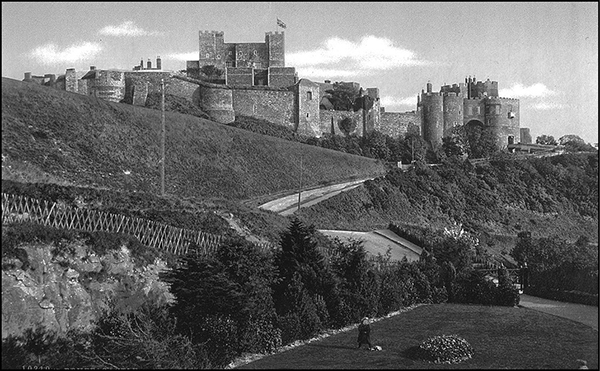
Overlooking the sea from a commanding and intimidating position, Dover Castle is situated at the shortest sea-crossing of the English Channel, which made it one of the most important defensive sites in Britain. Built in the twelfth century, records show there has been a fortified site at this location since Saxon times, and its crucial defensive position has seen it often referred to as the “Key to England.”
Built to guard England’s shores from pirates and in later years, Napoleon’s army, it is now best known for its role in the Second World War and its secret underground command center, which was often frequented by Winston Churchill.
In May 1940, Admiral Sir Bertram Ramsey directed Operation Dynamo, the evacuation of French and British soldiers from Dunkirk from headquarters in the cliff tunnels below the castle, and a military telephone exchange was installed in 1941 to serve the underground headquarters.
These days the castle is a Scheduled Monument and is a major tourist attraction. However, it holds more than just historical fascination for many. Indeed, for the ghost hunter or paranormal investigator, it is a veritable treasure trove with a number of ghostly occurrences being recorded at the site including the headless ghost of a drummer boy, possibly from Napoleonic times, who haunts the battlements. It is said that he was decapitated and robbed during an errand that involved a large sum of money. His spirit has been seen numerous times across the castle grounds, and his forlorn drumming is said to ring out at various times.
And not surprisingly for a structure of such age and historical turmoil, disembodied voices have been heard during the night, sudden unexplained drops in temperature have been recorded, and witnesses have reported doors opening and closing of their own accord. On one occasion a camera crew that was filming at the castle keep heard a loud scream from the battlements above, as if someone had thrown themselves or fallen over the edge. Thoroughly convinced that someone was falling toward them, they ran for cover only to realize that when the scream stopped, no body hit the ground.
Deep within the stone walls of the old keep the apparition of a cavalier has been seen, as well as a woman in a red dress. In the underground tunnels the ghosts of Second World War soldiers have made their presence felt as they endlessly go about their daily duties, as if unaware that the war ceased many decades ago. And it was in these areas that an American couple once had the fright of their life when they heard violent screams and cries for help. After settling down they consoled themselves by believing it to be part of a reenactment, only to be later chilled to the bone when they were told there were no events happening that day.
On one occasion, a group of schoolchildren were sketching in the tunnels. When they handed in their pieces of paper, one boy had written “Where is Helen?”, and when questioned, he told staff he had met a man in the tunnels dressed in a green jumper and brown trousers who was looking for a woman called Helen. A search was carried out but no one matching Helen was found. Neither, apparently, was the man in the green jumper and brown trousers, a dress that reminds one somewhat of a Second World War officer.
On another occasion, visitors on a guided tour reported that a door had suddenly slammed shut and a stretcher trolley exhibit had moved rapidly along the corridor, as if violently being pushed.
In September 2014, The Daily Mirror reported that a ghost, or what seemed to be a ghost, was caught on camera at the entrance to the historic castle. In a clip that lasts just over a minute, a dark wispy figure can be seen slowly walking across the entrance before disappearing; however, what makes it even more fascinating is the fact that the camera also picks up a bemused security guard as he searches for the figure.
Surrey
www.farnhamcastle.com
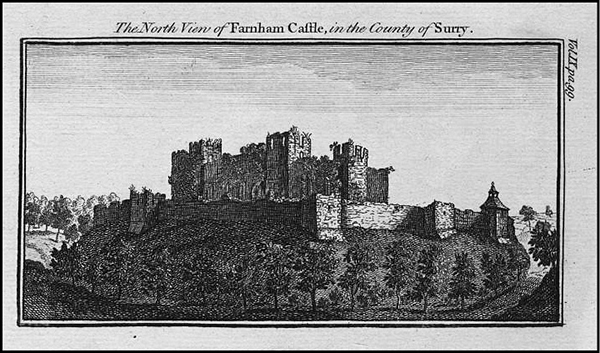
Originally built in 1138 by Henri de Blois, Bishop of Winchester and grandson of William the Conqueror, the castle was the home of the Bishops of Winchester for over eight hundred years.
The original building was demolished by Henry II in 1155 and then rebuilt in the late twelfth and early thirteenth centuries. In the early fifteenth century it was the home of Cardinal Henry Beaufort, who presided at the trial of Joan of Arc in 1414. After the Civil War in 1648, the castle was again destroyed but was rebuilt and added to by Bishop George Morley in the seventeenth century.
During the Second World War, the castle was the location of the Camouflage Development and Training Center and for the last fifty plus years has been an intercultural training and conference center
Witnesses visiting the twelft- century keep have reported seeing a ghostly male figure in a long garment that simply disappears into thin air when confronted. It is believed that this is the spirit of Bishop Morley, who apparently led a very simple life. He is also said to haunt Waynflete’s Tower, while the Great Hall is said to be haunted by the ghost of a young girl who, legend says, was forced to dance until she dropped dead. Some witnesses have reported seeing her ghostly figure, while others have reported hearing her tiny footsteps on the floor.
The staircase at the castle is also said to be haunted, again by Morley as well as by a monk in gray robes who is often seen gliding down the staircase and looking more flesh and blood than ghost. A shadowy figure has been witnessed in the area of the gateway, ramparts and keep, and the ghostly apparition of a stern lady in a light-colored gown has also been witnessed. It is believed that she originates from the twelfth century.
In addition, it has been often reported by town folk that they have heard bells ringing out for Waynflete’s Tower, even though the Tower hasn’t had bells in it for years. To add to this, the moat is said to be haunted by a procession of ghostly monks who appear extremely lifelike but then disappear. Even creepier, children have been heard on a number of occasions and voices reported coming from the Great Hall when no one has been in there.
Recently a security guard on patrol reported hearing mumbling and talking from the Great Hall. However, when he arrived there was no one there even though the talking continued. Apparently the guard exited the room and decided on doing outdoor patrols for that night. As well, a resident manager was sleeping overnight and awoke to see children standing at the end of the bed in medieval dress. Children have been seen and heard running along the length of the upper balcony, as if playing. It is also rumored that, in the cellar, a soldier who was shot in the face causes visitors to experience face-aches.
Peter Underwood, in his book Haunted Farnham, recalls meeting a person who was invited to spend a night at the castle. Underwood noted, “She told me she slept in an older part of the building and during the night found herself suddenly wide awake with the terrifying feeling that someone was in the room. She then felt her bedclothes being slowly pulled off her bed. Frightened, but aware of what was happening, she took a firm hold of the bedclothes and to her horror found that she had to exert considerable strength to keep the sheet and blanket from being drawn away from her.
“As she turned on her side to get a better hold on the bedclothes, she became aware that she could see ‘something’ in the corner of the bedroom. It seemed to have no definite shape but looked like someone crouching, huddled in the darkness, pulsating almost, exuding a sense of evil. After what seemed a long time struggling with the bedclothes and watching the unpleasant shape in the corner of the room, although it was probably only a few moments—or even seconds—the frightened visitor became aware that the dark form was no longer in the corner of the room and suddenly the bedclothes were no longer being tugged off the bed.”
Not surprisingly, after that experience she said that nothing would induce her to ever stay another night in the castle.
East Sussex
www.discoverhastings.co.uk
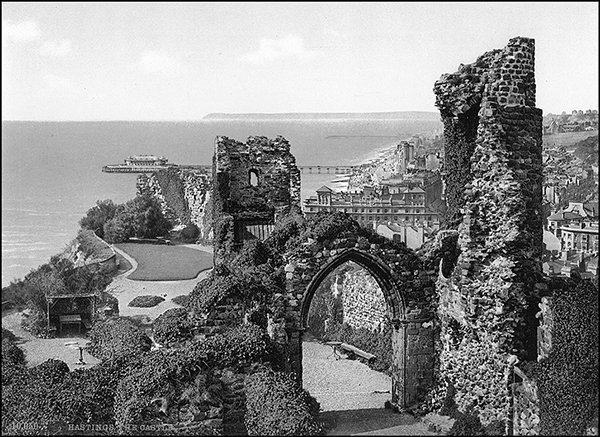
In 1066, William the Conqueror arrived in England and ordered three fortifications to be built: Pevensey Castle, Hastings Castle, and Dover Castle. Like most early Norman fortresses, Hastings Castle was originally a motte-and-bailey, which was later rebuilt in stone, and for most of the Norman period the castle was held by the Count of Eu.
Ferocious storms battered the south coast for many months in 1287 and the sandstone cliffs and parts of the castle fell into the sea. Throughout the following centuries, erosion continued and more and more of the castle was lost. During World War II, the castle received more damage, as Hastings was a target for German bombing raids. However, in 1951 the Hastings Corporation purchased the ruined site and converted it into a popular tourist attraction.
The ghost of Thomas Becket, who was thought to have been the church’s dean at one time, is said to wander the castle ruins and in an area known as The Ladies Parlour, where it is believed tournaments were held. It is said that the manifestation of a lady dressed in a shimmering white gown can still be seen on moonlit nights. The dungeons, known as the “Whispering Dungeons” took their name from the fact that prisoners were overheard talking by guards who were several yards away in another room, are also said to be haunted with the ghostly sounds of prisoners rattling their chains and calling out for food, while the ghost of a nun or cloaked woman has been seen on the West Hill.
Another ghostly woman carrying a child is seen—it is said that she was deserted by her lover, so she opted to end her life as well as her child’s by committing suicide. Apart from that, the ghost of a nun haunts the castle and the upper floors of the castle are subjected to phantom organ music. As well, a World War I nurse is said to haunt the nearby Wallingers Walk.
East Sussex
www.herstmonceux-castle.com
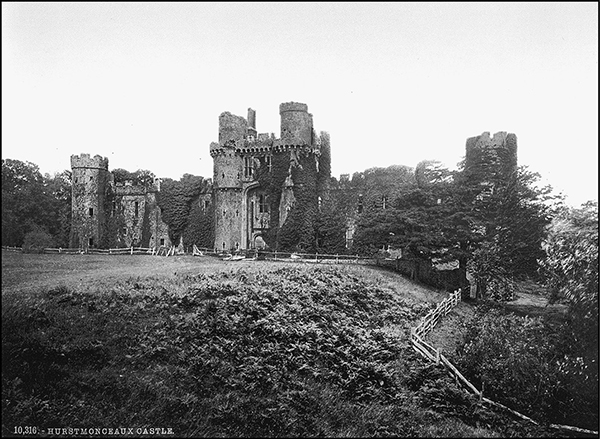
A stunning fairy tale–like castle that seemingly floats upon its moat, Herstmonceux Castle was built by Thomas Fiennes shortly after the Battle of Agincourt in the 1440s. It is one of the oldest significant brick buildings still standing in England, and although imposing, it was built more for its aesthetic qualities than defensive.
The Fiennes family maintained an important position at court for a century before Lord Thomas Dacre, had a disagreement with Henry VIII and was implicated in a murder. He was executed at Tyburn in 1541, and Henry seized the castle and estate. However, it was returned to the family when Elizabeth I came to power.
The castle remained untouched during the English Civil War, but by 1777 was in a state of disrepair due to the Fiennes’ profligate lifestyle and spending. It became a romantic, ivy-covered ruin and a popular destination for day-trippers. From 1957 to 1988 it became the home of the Royal Observatory, Greenwich and today it is used by the Bader International Study Centre of Queen’s University, Canada.
The ghost of a twenty-year-old woman haunts the castle moat. She is seen either swimming or standing beside the water and according to locals she drowned there on the eve of her twenty-first birthday. As well, the ghost of a Grey Lady is seen in the castle. It is thought that she is Grace Naylor, who was starved to death at the castle in 1727.
Additionally, a phantom drummer who emits a blue spark on every beat and who is said to be nine feet tall also haunts the battlements. He is thought to be the ghost of a drummer from the battle of Agincourt. Local legend suggests that the eccentric lord hammered on a drum in order to keep lovers away from his young wife. She eventually became so annoyed with him that she locked him in a tiny room and left him to die. The sound of his drum could still be heard long after his death and kept her lovers away.
A ghostly lady is often reported riding a white donkey around the castle grounds while the ghost of a White Lady has also been reported in the grounds of the castle. Legend says that she was lured to the castle by Sir Roger de Fienes, who raped her and then had her killed. Her ghost has been seen walking around the grounds of the castle’s moat in a distressed state. She has also been seen inside the castle close to the gatehouse. A phantom horse rider has also been reported galloping across nearby fields and is presumed to be Lord Dacre.
Kent
www.hevercastle.co.uk
Hever Castle was built around 1270 and first consisted of a walled bailey surrounded by a moat. However, in 1460, Henry Bullen, a wealthy London merchant, purchased the castle and converted it to a Tudor dwelling. His son Thomas changed his surname to Boleyn and later married Elizabeth Howard, the daughter of the Duke of Norfolk.
Together the two had many children, one being Anne Boleyn, whose name is now synonymous with the quaint stone building. Anne, who later married Henry VIII, was arrested and charged with adultery and incest and was sentenced to death at the Tower of London. She was beheaded on May 19, 1536.
It is Anne’s ghost who seems to haunt this most beautiful and evocative building. Indeed, one could even suggest that her spirit is one of the most, if not the most, reported ghosts of all time. Interestingly, as we have previously seen regarding the Tower of London, Anne’s ghost not only appears at Hever but also Blickling Hall in Norfolk, Rochford Hall in Essex, and as we shall see, Windsor Castle as well.
In May 2010, I was fortunate enough to spend a good half day at the castle, wandering its grounds and exploring its magnificent hallways, stairwells, and rooms, including the room rumored to be that of Anne’s—a bedroom she shared with her sister Mary. The bedroom itself is somehow atmospheric as if history itself seeps from its stone walls and dark timber furniture. Leaning against the fireplace one cannot help but realize that Anne herself must have done the same at some stage. Indeed, looking out the window is to see the landscape that Anne must have loved so much as a child, albeit, restored and remodeled over the years.
It is quiet and peaceful at this time, I have somehow luckily escaped the crowds for this moment, and for an instant I am able to be alone in this truly splendid place. I gaze out of the window at the lush green lawns and mature trees that sit serenely in the warmth and sunlight of an early English summer. Turning around I feel as if someone or something is in the room with me, as if watching quietly from a corner, unseen and unheard. But of course, there is no one there, and soon my serenity is broken by the arrival of a family with day packs and cameras and noisy children. The moment is gone, whatever ghosts that haunt this room have gone. And yet, for a fleeting moment, one could believe they exist.
Anne’s ghostly apparition has been seen wandering the gardens of the castle, often drifting over the bridge that crosses the River Eden. As well, her figure has been reported in what is thought to have been her bedroom. Is it too much of a stretch to suggest that her restless spirit has returned to a place where she spent many happy years, and from where she began her journey that would change the face of history for England?
Other ghosts at Hever Castle include a despondent spirit of unknown origin who wanders the gallery, often groaning and banging. As well, a phantom horse has also been seen, oddly enough, galloping through the long gallery.
In 2015 a tourist, Liam Archer, who was visiting the castle, captured an eerie image of what he claimed is the ghost of Anne Boleyn stalking the corridors. After spending an afternoon at the castle with his family and taking various photographs including one of an ornate fireplace in a dimly-lit living room, Archer he took the picture which appears to show something out of the ordinary.
Unaware of it at the time, he was surprised to find what looked like a hovering hand with a long finger apparently pointing towards the chimney. He noted afterward, “In the prayer room there was a fog or a mist hovering around, but I didn’t think much of it at the time. I felt like an unknown force was pulling me through the castle. I couldn’t see it, but I could definitely feel it. I didn’t know what to make of it because I didn’t believe in ghosts at this point. But I am now confident it is her.”
Kent
www.leeds-castle.com
With a site dating back to 857, one would think Leeds Castle in Kent, some five miles southeast of Maidstone, would be teeming with ghosts and ghostly stories. However, contrary to this, if anything, it appears quiet in supernatural phenomena.
A stunning and imposing fortress of stone seemingly floating on a shallow lake, and invoking visions of the Arthurian Avalon, my partner Kirsten and I visited the castle on a day when the sun shone merrily through high wispy clouds and the day was warm. The scent of an English spring wafted pleasantly past our nostrils and small sparrow like birds twittered incessantly in the bushes and hedgerows.
To reach the castle you must park your car and then walk along a crunchy gravel path that winds its way through stunning gardens of beautifully manicured lawns, regimented hedges, and imposing trees. The visitors then follow the path as it runs parallel to a small brook that cheerfully babbles its way through this wonderful landscape. If you are lucky you may run into the resident peacocks or spy a fat pike lurking in the shallows.
A castle has been on the site since 1119 and was used by King Edward I in the thirteenth century, while Henry VIII used it as a residence for his first wife, Catherine of Aragon, in the sixteenth century. These days the castle dates mostly from the nineteenth century and is built on the islands in a lake formed by the River Len. Known as a ‘ladies castle’ and for its stunningly beautiful location, it is a popular tourist attraction and has been open to the public since the mid-1970s.
Surprisingly, the main ghost that is said to haunt Leeds is not a vague woman in red or white or even a ghostly cavalier, instead it is a black dog which is said can appear and disappear within moments, sometimes fading into a wall or passing through closed doors. The dog is said to terrorize the castle grounds and has become associated with a death or other misfortune befalling a member of the castle owner’s family.
Interestingly, one story that is widely believed contradicts this beast-of-misfortune legend as many years ago a woman was sitting by a window when she saw the spectral dog disappearing into a wall. The woman went to investigate when the window by which she had been sitting suddenly collapsed, the bricks and rubble landing on the spot where she had been just moments before.
The origin of the ghostly dog is said to lie in the witchcraft dabbling of Henry VI’s aunt, Eleanor of Gloucester, who in 1431 was found guilty of practicing necromancy, witchcraft, heresy, and treason. As a result, she was imprisoned at Leeds Castle for life. Some have speculated that the dog may have been cursed in some way and as such is doomed to haunt the castle forever.
Apart from that, witnesses have also reported seeing a ghostly woman gliding along the corridors of the castle, and she is believed to be none other than the Duchess of Gloucester herself. As well, the apparition of a woman in a long flowing dress brushing her hair has also been seen in the grounds and in the Queen’s Room
More recently the ghosts of two other dogs have been reported, a small white dog and a much larger black dog. They are believed to have been the pets of Lady Baillie, an Anglo-American heiress and previous owner of the castle, who owned a small terrier called Smudge and a Great Dane called Boots.
Interestingly, although not a classic ghost sighting, an incident regarding a so called time-slip has been reported from the castle when a woman, Alice Pollock, was touching objects in the Henry VIII’s rooms in an attempt to experience events from another time. After a short period of receiving no impressions, she reported that the room suddenly changed, losing its modern, comfortable appearance and becoming cold and bare. The carpet had disappeared and there were now logs burning on the fire, while a tall woman in a white dress was walking up and down the room; her face appearing to be in deep concentration. Not long after the room returned to its original state.
Later research showed that the rooms had been the prison of Queen Joan of Navarre, Henry V’s stepmother after she had been accused of witchcraft by her husband.
Oxfordshire
www.oxfordcastleunlocked.co.uk
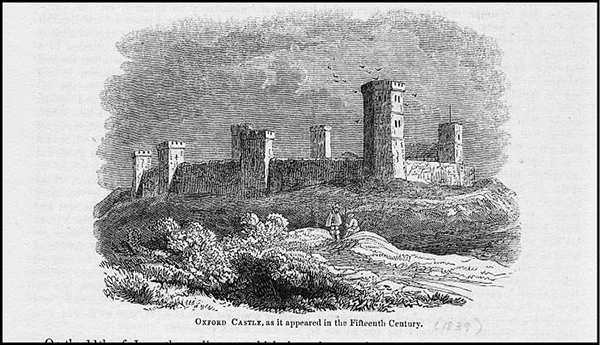
Oxford Castle lies in the heart of Oxfordshire with a history dating as far back as the Norman Conquest of England. First built by Robert D’Oyly the Elder, it is somewhat surprisingly not among the forty-eight castles recorded in the Domesday Book of 1086. However, it must be noted that for all its remarkable detail, not every castle in existence at the time was recorded in the survey.
D’Oyly arrived in England with William the Conqueror during the Norman Conquest of England in 1066. Later William granted him lands in Oxfordshire, and as Oxford had suffered considerable damage during the invasion, D’Oyly was directed by William to construct a castle to control the town.
Originally a moated, wooden motte-and-bailey, the castle was replaced in stone in the eleventh century and played an important role in the Conflict of the Anarchy, a civil war in England and Normandy between 1135 and 1153, which resulted in a widespread breakdown in law and order. However, in the fourteenth century the site became used primarily for county administration and as a prison. During the English Civil War, most of the castle was destroyed, and by the eighteenth century, the remaining buildings where converted into Oxford’s local prison. A new prison complex was built on the site from 1785, which became HM Prison Oxford. In 1996 the prison closed and was redeveloped as a hotel with the medieval remains of the castle, including the motte, St George’s Tower, and the crypt being Grade I buildings as well as Scheduled Monuments.
And with such a history of execution, murder, hardship, depravity, and intense fighting, it is hardly surprising that the castle is one of the most haunted in England, with people reporting dark shadowy figures, poltergeist activity and more.
The ghostly figure of a woman has been seen walking the Castle Mound, and many believe that this is the restless spirit of Mary Blandy, who was executed for murder at the castle in 1752. In addition, it was reported that sometime in the 1970s a paranormal investigation group was carrying out a séance in one of the cells when poltergeist activity suddenly began to occur—things getting so bad that a priest had to be called to exorcise whatever strange entity they had accidentally summoned.
Disembodied footsteps are also often heard around the prison wing corridor, and an amorphous white mist has often been reported rising up a flight of stairs only to disappear once it reaches the top.
However, perhaps the most frightening report came from some security guards who were on a nightly patrol. Security staff at the castle have long reported many strange things, such as unexplained sounds, bangs, and disembodied voices. However, one night a guard was coming to the end of his patrol when his dog stopped and quickly backed up, growling at something in front of him. Then, as the guard tried to calm the dog, two large shadowy figures appeared before him. Terrified, he immediately ran in the opposite direction to escape whatever it was. Sadly, it was reported that the dog died a few days later, apparently frightened to death.
In March 2014, Tim Stanley wrote in the Telegraph of a ghost hunt he attended at the castle with Dr. Ciarán O’Keeffe, a lecturer in parapsychology. Stanley, who claims to have witnessed a ghost when he was ten years old recalled that while alone in the crypt he, “suddenly found that I was not alone. How to describe it? It was similar to the feeling that you might get when your eyes are closed and someone walks into the room. You cannot hear or see them, but you know that they are there. I knew that standing to my right-hand side was a little girl. I couldn’t see her or touch her and she said nothing. But she was there.”
Later O’Keeffe clarified the situation by stating that “Some mediums have, in the past few months, said that they think there is a little girl in the crypt, too.”
To this day, the original motte, crypt, and St George’s Tower remain and are a popular, if grim, location for paranormal investigations and ghost tours.
East Sussex
www.english-heritage.org.uk/visit/places/pevensey-castle
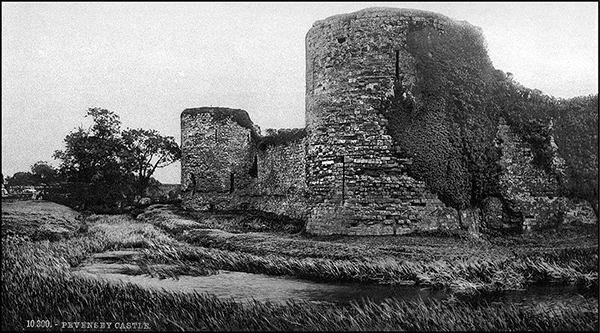
Built around 290 AD and known to the Romans as Anderitum, Pevensey Castle is a medieval castle and former Roman Saxon Shore fort. It is a Scheduled Monument and is long thought to have been originally built as a Roman defense to guard the British coastline from Saxon pirates.
Anderitum fell into ruin following the end of the Roman occupation but was reoccupied in 1066 by the Normans. A stone keep and fortifications were built within the old Roman walls and although it was twice starved into surrender, it was never successfully stormed. It was generally occupied until the sixteenth century when it became abandoned until it was acquired by the state in 1925. Between 1940 and 1945 it was garrisoned by units from the Home Guard, the British and Canadian armies, and the United States Army Air Corps, and machine-gun posts were built into the Roman and Norman walls. These emplacements can still be seen today.
The most famous ghost that haunts the castle is “The Lady in White.” She has apparently appeared a number of times in the surrounding fields. Indeed, it was reported that one summer’s evening a few years ago a group of twelve campers were putting up their tents in a field adjacent to the castle when one of them saw, in the next field, what he thought was an old lady dressed in a long white raincoat that came down to her ankles. He then realized that she wasn’t walking but gliding and so called his friends and they all watched her float up the hill toward the castle, at one stage passing right through a wooden fence. They decided to give chase; however, as they got close to the strange apparition, it drifted into some bushes. The campers surrounded the bushes but found no sign of anyone. This was enough for them and they packed up and left.
In addition to this, a “gray or pale lady” is said to haunt the ruined interior of the castle. She has been seen slowly pacing up and down one of the parapets and there has been some speculation as to her identity with some suggesting that she is Lady Joan Pelham, whose husband took over the castle in 1394. When he was called away to fight a battle in the north, Lady Pelham was left at Pevensey in charge of the castle. With the majority of soldiers gone, the castle was besieged by an invading army demanding its surrender in the name of King Richard II.
Lady Pelham, now trapped in her own castle, not only feared for her own life but also that of her husband’s. She managed to hold on, later pacing the parapet every day until he returned. However, it was said that she suffered a great deal of mental trauma from the siege, and this is the reason that her restless and troubled spirit still walks the battlements.
Others, however, suggest that the spirit is that of Queen Joan of Navarre, wife of Henry IV and stepmother to Henry V. She was falsely charged with witchcraft and later held in custody at Pevensey Castle in 1419. She was released several years later when Henry V reprieved her, apparently feeling remorse for the ill-treatment she received, something she apparently never got over.
Other sightings include a Roman centurion marching on the castle battlements, and the ghost of a drummer boy who, according to locals, is still beating out the alarm of a Saxon attack. A number of people have reported that they have heard the sounds of marching soldiers and the screams and moans of dying men drifting across to the castle from the site of the 1066 Battle of Hastings, while a black monk has been sighted in a nearby valley. Interestingly, it is suspected that this ghost is of a relatively recent origin, as much of the land in that area around the castle was covered by the sea until only a few hundred years ago.
More recently, a local resident of the area claimed to have seen a ghost three days in a row, each time at six in the morning while walking his dog. Apparently the man would walk his dog every morning before work and on one of these days he noticed someone dressed in black on the far side of a field. Thinking that it was someone else out for an early walk he gave it no thought; however, he saw the same figure the very next day and again on a third successive day. Picking up a stick and throwing it for the dog to retrieve, the wind caught the stick and blew it toward the figure, landing behind it. To the astonishment of the owner, the dog ran straight through the body of the black figure.
Frightened by what he had witnessed, the man left the field immediately but returned again the next morning. However, he never saw the black figure again.
Hampshire
www.english-heritage.org.uk/visit/places/portchester-castle
Portchester Castle is located at the northern end of Portsmouth Harbour in Hampshire. It is a medieval castle built within a former Roman fort. Believed to have been founded in the late eleventh century, Portchester was a baronial castle and was a favored hunting lodge of King John. In 1216 it was besieged and captured by the French, although not held for any great length of time before being retaken and returned to English control
The castle itself occupies a commanding position at the head of Portsmouth Harbour and, in anticipation of a French invasion during the first part of the fourteenth century, Edward II repaired and reinforced its already daunting battlements.
In 1632 the castle was sold to Sir William Uvedale. Since then, it has passed through a number of his successors and, although it did not witness fighting during the English Civil War, it was garrisoned by Parliamentarian dragoons in 1644, mounted infantry who were trained in horse riding as well as infantry fighting skills.
However, the castle is renowned these days as being a prison, one of its common uses especially from the late seventeenth century onward when it took on this important function in a full-time capacity. In 1665, some five-hundred prisoners from the second Anglo-Dutch war were held within its towering walls and between 1702 and 1712 the Crown leased Portchester Castle from its owners to imprison prisoners from the Spanish War of Succession.
It was last used as a gaol in the nineteenth century for over 7000 French prisoners of the Napoleonic Wars. Those unfortunate souls that died in captivity were often buried in what are now the tidal mudflats to the south of the castle, and their remains occasionally rise from the mud when disturbed by storms.
Today Portchester Castle is a Scheduled Ancient Monument and a Grade I building, and although appearing quiet by the standards of many haunted English castles, is still reputed to be haunted by several ghosts—a black monk and a spectral horseman seen riding through the grounds. Indeed, with regards to the latter, in one encounter Sheila Sayce, an employee leading a tour of the grounds, was convinced she witnessed a ghostly black horse and rider. She noted; “As it grew in size, it started to come towards me and I screamed and ran away. My colleague saw it over my shoulder too—it was a long, low, jet black shape with four legs and a horse’s head and it projected a very bad feeling.”
Sayce also noted “The following year a young lad came in with a video. He had been larking around outside the castle late one night and wanted to know if we could identify a strange sound on the tape. It was the sound of horse’s hooves on concrete.”
There has also been evidence of satanic witchcraft rituals found within the graveyard which sits within the castle walls. As well, a woman who fell to her death while trying to rescue her baby is said to roam the grounds, as does the spirit of a girl who was said to have thrown herself off the walls in the seventeenth century after hearing of the death of her fiancé at sea.
Interestingly, local legend suggests that Pontius Pilate visited here late in his life although, obviously, the current castle would not have existed at this time.
It is truly a spectacular place to visit, something I did in the early summer of 2010, and although I didn’t witness anything of a supernatural nature, I am not surprised that tales of ghost’s comings-and-goings abound from this incredible site.
Kent
www.english-heritage.org.uk/visit/places/rochester-castle
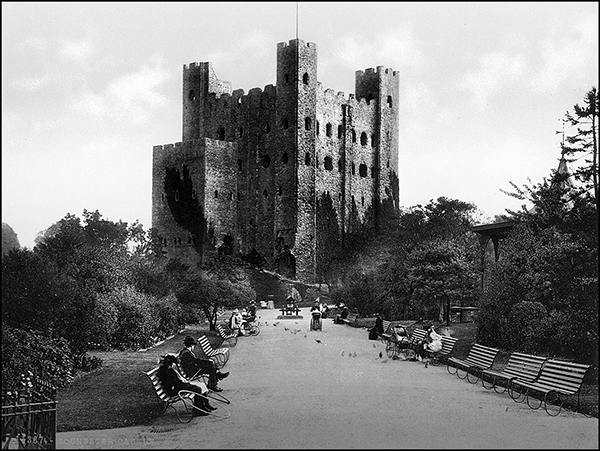
Situated on the River Medway and Watling Street, Rochester Castle served as an important royal castle and helped protect England’s south-east coast from invasion during the late-medieval period.
The first castle at Rochester was founded just after the Norman Conquest. It was given to Bishop Odo, probably by his half-brother William the Conqueror.
During the Rebellion of 1088 over the succession to the English throne, Odo supported Robert Curthose, William’s eldest son, against William Rufus and the castle first saw military action when both the city and castle were besieged after Odo made Rochester a headquarters for the rebellion. Afterward the first castle was abandoned.
Between 1087 and 1089, Rufus built a new stone castle at Rochester, and although much altered these days, some of the original parts still remain. The twelfth-century keep or stone tower, which is the castle’s most prominent feature, is one of the best preserved in England.
The ghost of Lady Blanche de Warenne has been seen walking the castle battlements, protruding from her chest the arrow that accidentally killed her at Easter in 1264. According to legend, the arrow was tragically fired by her betrothed in an attempt to protect her from the unwanted attentions of another man—the arrow bouncing off the armor of its intended target and striking Lady Blanche, killing her instantly.
Another ghostly woman, or possibly the same, has also been regularly reported. In December 2007 a visitor reported seeing a lady in medieval garments walking down a spiral staircase in the castle before walking through a wall and disappearing, while in 2010 another visitor to the castle reported that, while in the gallery, they distinctly heard a woman whisper in their ear. In 2010 another visitor reported seeing a transparent figure in one of the upper floors and that it walked through an archway and then across thin air as though there was still a floor in place.
A fact sheet given out by staff states: “In the chapel, which now has the model of the castle in it, and directly above the shop, which would have originally been the fore building, there is a presence of a man, possibly a man of the cloth (priest).”
In February 2008, a tall dark figure was seen by a witness who became extremely distressed. During the same year another witness reported hearing “footsteps behind me and (I) looked around and in the shadows I saw a hooded figure that said in no uncertain terms, ‘Get out!’”
Oddly enough, a couple visiting the castle earlier that year reported that “My husband and I were walking around the middle section of the castle when, without warning, it went icy cold all around us and we both heard a voice, in a whispery rasp say, ‘Go away!’”
In 2009 another couple reportedly noted a drop in temperature and the same voice saying the same words, while another visitor reported seeing a monk in the chapel. Strangely, another couple in the room at the same time failed to see the apparition.
Neil Arnold, in his book Haunted Rochester also notes that, in 2006, a married couple visiting the castle were alarmed by a sudden white fog which appeared near the ladder to the cesspit, while in October of the same year, a man with white hair was seen gazing out of one of the unoccupied windows. In June 2007 a man reported that he’d seen a strange mist and two orb like objects emerging from the well. Arnold also reports that in 2010 some visitors from Iceland encountered two men dressed in medieval attire but, upon later enquiring of them, were told that there were no re-enactments at the castle that day.
The ghost of an old man, thought to be that of Charles Dickens, has been seen near the Old Burial Ground by the castle moat. Dickens was said to have loved Rochester and expressed a wish to be buried there, however, after his death he was interred in Westminster Abbey as this was considered the only place suitable for such a great author. Whatever the case, it appears that Rochester Castle is a place where encountering supernatural spirits is not unusual.
Kent
www.nationaltrust.org.uk/sissinghurst-castle
Although Sissinghurst is technically not a castle, contemporary records suggest that the site was occupied by a moated manor house in the late twelfth century and by the middle of the thirteenth century belonged to the de Bereham family who held it until Henry de Bereham sold it to Thomas Baker in the late 1400s. The Bakers, however, backed the Royalists during the English Civil War and by the late seventeenth century the place was in serious decline. From 1756 to 1763 it was let to the government as a military prison also resulting in considerable damage.
These days it is owned and maintained by the National Trust and is among the most famous gardens in England, being created in the 1930s by Vita Sackville-West, poet and gardening writer, and her husband Harold (later Sir Harold) Nicolson, an author and diplomat. It is, of course, reputed to be haunted.
A number of unnamed ghosts are said to haunt Sissinghurst Castle, most of which appear to stem from the time of Queen Mary’s reign when Sir John Baker resided in the castle. Sir John was known for the execution of hundreds of Protestants and was referred to as “Bloody Baker” and was rumored to have murdered a local priest whose ghost now wanders the grounds. The priest, who legend suggests was bricked up alive in one of the buildings walls, is often heard by visitors, his eerie disembodied footsteps walking beside them on the crunchy gravel paths. Indeed, famed ghost hunter Peter Underwood noted, “In the 1950s, Felix Seward, Chairman of the Ghost Club from 1954 to 1960, knew both Sir Harold and Lady Nicolson and, knowing of his great interest in psychic matters, they talked freely to him about the ghost priest.”
Underwood added that on one occasion, while speaking with Sir Harold over lunch, he was told that the priest had been seen, heard, and felt on numerous occasions, even by Sir Harold himself. This was backed up by the housekeeper, a Mrs. Hayter, who reported that many visitors had asked her whom the “reverend gentleman” was who was lurking around the place.
Underwood also suggests that Sir Harold himself now may haunt the place, noting that, “Sir Harold had the occasional habit of clicking his teeth with his tongue—and oddly, since his death a peculiar clicking noise has been heard in some of the rooms in the house.”
Berkshire
www.royalcollection.org.uk/visit/windsorcastle
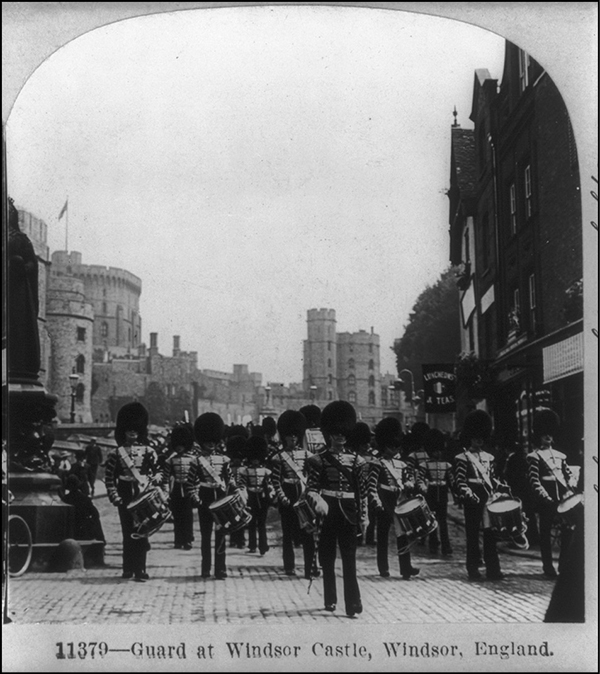
Built by William the Conqueror in 1066, Windsor Castle was originally a timber motte-and-bailey structure designed to protect Norman authority around the outskirts of London and to protect a strategically important part of the River Thames. The earliest mention of Windsor is in the Anglo-Saxon Chronicle and comes from the English word windles-ore, which means “winch by the riverside”.
The castle was gradually replaced with stone fortifications over the years and withstood a prolonged siege during the First Barons’ War at the start of the thirteenth century. Later, Henry III built a luxurious royal palace within the castle during the middle of the century, while Edward III further refurbished and rebuilt the palace to become what was described as the “most expensive secular building project of the entire Middle Ages in England.” During the sixteenth century, Henry VIII and Elizabeth I used the castle predominantly as a royal court.
Surviving the English Civil War, when it was used as a military headquarters for Parliamentary forces and a prison for Charles I, it was later rebuilt again, this time by Charles II, and after a period of neglect during the eighteenth century, George III and George IV renovated once again. Queen Victoria later made a few minor changes to the castle, which became the center for royal entertainment for much of her reign. During the Second World War it became a place of refuge for the royal family during the Luftwaffe bombing campaigns. In 1992 it survived a devastating fire. Today it is the largest inhabited castle in the world, with more than 500 people living and working within its forbidding walls.
The castle has stood for nearly a thousand years in one form or another, and not surprisingly, it has many ghostly stories to tell, including that of the ghost of Henry VIII, who is said to be one of the most famous otherworldly inhabitants of the castle. Numerous people, including employees and visitors, report having heard the king in the cloisters. As well, he has also been seen wandering the corridors, moaning in pain and dragging his ulcerated leg behind him, an infection that greatly contributed to his death in 1547. He is often described by witnesses as a large and angry ghost irately pacing and occasionally shouting.
Anne Boleyn, who we have already seen seems to haunt a number of places, is another of the castle’s many resident ghosts. The second wife of Henry VIII and beheaded in the Tower of London in 1536, her ghost is reported to haunt the Dean’s Cloister at the castle and she had been seen numerous times peering through a window, her face drawn and distressed and sometimes weeping.
Elizabeth I, the youngest daughter of Henry VIII, has also been seen on numerous occasions, generally in the Royal Library, with people reporting hearing the sound of her high heels on the floorboards. She has also been seen a number of times at a window in the Dean’s Cloister wearing a black gown and a back shawl.
As well, the ghost of King George III, who was often restricted to the castle, especially during his periods of madness, is said to appear in the library, peering mournfully through the windows and doorways.
And not surprisingly for a building of such age and history, there are numerous places within the castle walls that are reputed to be haunted by a number of unknown, or unnamed ghosts, such as the Curfew Tower, the Deanery and the Prison Room.
Interestingly, the ghost of Queen Victoria is reputed to have been displeased with the renovations made to the castle by her grandson Edward VIII, in particular, the removal of a specific spruce tree. When workers came to remove the tree, a number of inexplicable events hampered the removal and some even claimed to see the ghost of the old matriarch waving her arms wildly.